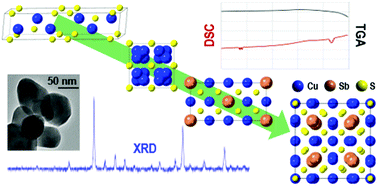Synthetic versatility, reaction pathway, and thermal stability of tetrahedrite nanoparticles†
Abstract
Copper-antimony-sulfide compounds have desirable earth-abundant compositions for application in renewable energy technologies, such as solar energy and waste heat recycling. These compounds can be synthesized by bottom-up, solution-phase techniques that are more energy and time efficient than conventional solid-state methods. Solution-phase methods typically produce nanostructured materials, which adds another dimension to control optical, electrical, and thermal material properties. This study focuses on a modified-polyol, solution-phase synthesis for tetrahedrite (Cu12Sb4S13), a promising thermoelectric material with potential also for photovoltaic applications. To dope the tetrahedrite and tune material properties, the utility of the modified polyol synthetic approach has been demonstrated as a strategy to produce phase-pure tetrahedrite that incorporates transition metal (Fe, Co, Ni, Zn, Ag) dopants for Cu, Te dopant for Sb, and Se for S. Six of these reported tetrahedrite compounds have not previously been made by solution-phase methods. For the bottom-up formation of the tetrahedrite nanomaterials, the evolution of the chemical phases has been determined by an investigation of the reaction progress as a function of temperature and time. Digenite (Cu1.8S), covellite (CuS), and famatinite (Cu3SbS4) are identified as key intermediates and are consistently observed for both undoped and doped tetrahedrites. The effect of nanostructuring and doping tetrahedrite on thermal properties has been investigated. It was found that nanostructured undoped tetrahedrite has reduced thermal stability relative to samples made by solid-state methods, while the addition of dopants for Cu increased the thermal stability of the material. Crystallinity, composition, and nanostructure of products and intermediates were characterized by powder X-ray diffraction, scanning electron microscopy with energy dispersive X-ray spectroscopy, and transmission electron microscopy. Thermal properties were investigated by differential scanning calorimetry and thermal gravimetric analysis. This synthetic study with thermal property analysis demonstrates the potential of the modified polyol method to produce tetrahedrite and other copper-antimony-sulfide compounds for thermoelectric and photovoltaic applications.



 Please wait while we load your content...
Please wait while we load your content...